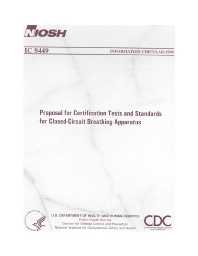Mining Publication: Proposal for Certification Tests and Standards for Closed-Circuit Breathing Apparatus
Original creation date: August 1999
Significant portions of the present Federal regulations for certification of closed-circuit breathing apparatus (42 CFR 84) are not quantitative. The human-subject testing portion of the regulations specifies activities rather than metabolic work rates; however, heavy human subjects have higher oxygen consumption, CO2 production, and ventilation rates than lighter human subjects performing the same activities. This means that apparatus certified using different human subjects have effectively passed different tests. In addition, apparatus performance is monitored only during selected intervals of testing, and always during rest, rather than during the entire performance period. Further, testing is arbitrarily terminated at specific rated durations, leaving unknown the performance during the remaining duration. Duration itself is misleading to users who believe that the apparatus will last a certain time no matter how much they weigh or how hard they work. The actual duration obtained from an apparatus, however, is highly variable, being inversely proportional to the work rate at which it is used. In this report, recommendations are made to (1) replace the present regulations for certification of closed-circuit breathing apparatus with quantitative tests specifying metabolic work rate rather than activity, (2) continuously monitor relevant physiological stressors, (3) continue testing until exhaustion of the oxygen source, and (4) classify closed-circuit breathing apparatus by quantity of usable oxygen, i.e., capacity, rather than by duration. Physiology-based stressor levels are suggested as well.
Authors: N Kyriazi
Information Circular - August 1999
NIOSHTIC2 Number: 20000248
Pittsburgh, PA: U.S. Department of Health and Human Services, Public Health Service, Centers for Disease Control and Prevention, NIOSH, DHHS (NIOSH) Pub No. 99-144, Information Circular 9449, 1999; :1-12
See Also
- 3+3 SCSR Donning Screen Saver - 1.0
- Advances in Remote Sensing Techniques for Monitoring Rock Falls and Slope Failures
- Applications of Ground-Based Radar to Mine Slope Monitoring
- Effect of Coal Type and Oxyfuel Combustion Parameters on Pulverised Fuel Ignition
- Monitoring and Removal of CO in Blasting Operations
- Performance Comparison of Rescue Breathing Apparatus
- Remote Monitoring of Mine Seismicity and Earthquakes Using Radio Telemetry, Computers, and the Internet
- Safe and Economical Inerting of Sealed Mine Areas
- Safer Mine Hoisting With Conveyance Position and Load Monitoring
- Self-Contained Self-Rescuer Donning Proficiency at Eight Eastern Underground Coal Mines
- Content source: National Institute for Occupational Safety and Health, Mining Program


 ShareCompartir
ShareCompartir
